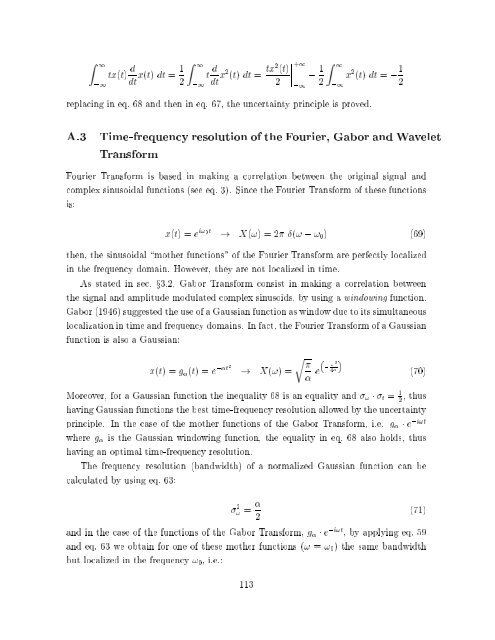Quantitative analysis of EEG signals: Time-frequency methods and ...
Quantitative analysis of EEG signals: Time-frequency methods and ...
Quantitative analysis of EEG signals: Time-frequency methods and ...
Create successful ePaper yourself
Turn your PDF publications into a flip-book with our unique Google optimized e-Paper software.
Z 1<br />
;1<br />
tx(t) d dt x(t) dt = 1 2<br />
Z 1<br />
;1<br />
t d dt x2 (t) dt = tx2 (t)<br />
2<br />
<br />
+1<br />
;1<br />
; 1 2<br />
Z 1<br />
;1<br />
x 2 (t) dt = ; 1 2<br />
replacing in eq. 68 <strong>and</strong> then in eq. 67, the uncertainty principle is proved.<br />
A.3 <strong>Time</strong>-<strong>frequency</strong> resolution <strong>of</strong> the Fourier, Gabor <strong>and</strong> Wavelet<br />
Transform<br />
Fourier Transform is based in making a correlation between the original signal <strong>and</strong><br />
complex sinusoidal functions (see eq. 3). Since the Fourier Transform <strong>of</strong> these functions<br />
is:<br />
x(t) =e i! 0t<br />
! X(!) =2 (! ; ! 0 ) (69)<br />
then, the sinusoidal \mother functions" <strong>of</strong> the Fourier Transform are perfectly localized<br />
in the <strong>frequency</strong> domain. However, they are not localized in time.<br />
As stated in sec. x3.2, Gabor Transform consist in making a correlation between<br />
the signal <strong>and</strong> amplitude modulated complex sinusoids, by using a windowing function.<br />
Gabor (1946) suggested the use <strong>of</strong> a Gaussian function as window due to its simultaneous<br />
localization in time <strong>and</strong> <strong>frequency</strong> domains. In fact, the Fourier Transform <strong>of</strong> a Gaussian<br />
function is also a Gaussian:<br />
r <br />
<br />
x(t) =g (t) =e ;t2 ! X(!) =<br />
e<br />
; !2<br />
4<br />
<br />
(70)<br />
Moreover, for a Gaussian function the inequality 68isanequality <strong>and</strong> ! t = 1 2 ,thus<br />
having Gaussian functions the best time-<strong>frequency</strong> resolution allowed by the uncertainty<br />
principle. In the case <strong>of</strong> the mother functions <strong>of</strong> the Gabor Transform, i.e. g e ;i!t<br />
where g is the Gaussian windowing function, the equality in eq. 68 also holds, thus<br />
having an optimal time-<strong>frequency</strong> resolution.<br />
The <strong>frequency</strong> resolution (b<strong>and</strong>width) <strong>of</strong> a normalized Gaussian function can be<br />
calculated by using eq. 63:<br />
2 ! = 2<br />
(71)<br />
<strong>and</strong> in the case <strong>of</strong> the functions <strong>of</strong> the Gabor Transform, g e ;i!t , by applying eq. 59<br />
<strong>and</strong> eq. 63 we obtain for one <strong>of</strong> these mother functions (! = ! 0 ) the same b<strong>and</strong>width<br />
but localized in the <strong>frequency</strong> ! 0 , i.e.:<br />
113




